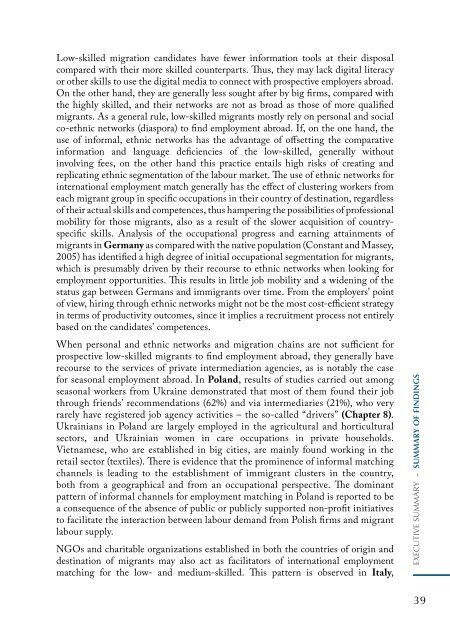International Organization for Migration (IOM)
International Organization for Migration (IOM)
International Organization for Migration (IOM)
You also want an ePaper? Increase the reach of your titles
YUMPU automatically turns print PDFs into web optimized ePapers that Google loves.
Low-skilled migration candidates have fewer in<strong>for</strong>mation tools at their disposal<br />
compared with their more skilled counterparts. Thus, they may lack digital literacy<br />
or other skills to use the digital media to connect with prospective employers abroad.<br />
On the other hand, they are generally less sought after by big firms, compared with<br />
the highly skilled, and their networks are not as broad as those of more qualified<br />
migrants. As a general rule, low-skilled migrants mostly rely on personal and social<br />
co-ethnic networks (diaspora) to find employment abroad. If, on the one hand, the<br />
use of in<strong>for</strong>mal, ethnic networks has the advantage of offsetting the comparative<br />
in<strong>for</strong>mation and language deficiencies of the low-skilled, generally without<br />
involving fees, on the other hand this practice entails high risks of creating and<br />
replicating ethnic segmentation of the labour market. The use of ethnic networks <strong>for</strong><br />
international employment match generally has the effect of clustering workers from<br />
each migrant group in specific occupations in their country of destination, regardless<br />
of their actual skills and competences, thus hampering the possibilities of professional<br />
mobility <strong>for</strong> those migrants, also as a result of the slower acquisition of countryspecific<br />
skills. Analysis of the occupational progress and earning attainments of<br />
migrants in Germany as compared with the native population (Constant and Massey,<br />
2005) has identified a high degree of initial occupational segmentation <strong>for</strong> migrants,<br />
which is presumably driven by their recourse to ethnic networks when looking <strong>for</strong><br />
employment opportunities. This results in little job mobility and a widening of the<br />
status gap between Germans and immigrants over time. From the employers’ point<br />
of view, hiring through ethnic networks might not be the most cost-efficient strategy<br />
in terms of productivity outcomes, since it implies a recruitment process not entirely<br />
based on the candidates’ competences.<br />
When personal and ethnic networks and migration chains are not sufficient <strong>for</strong><br />
prospective low-skilled migrants to find employment abroad, they generally have<br />
recourse to the services of private intermediation agencies, as is notably the case<br />
<strong>for</strong> seasonal employment abroad. In Poland, results of studies carried out among<br />
seasonal workers from Ukraine demonstrated that most of them found their job<br />
through friends’ recommendations (62%) and via intermediaries (21%), who very<br />
rarely have registered job agency activities – the so-called “drivers” (Chapter 8).<br />
Ukrainians in Poland are largely employed in the agricultural and horticultural<br />
sectors, and Ukrainian women in care occupations in private households.<br />
Vietnamese, who are established in big cities, are mainly found working in the<br />
retail sector (textiles). There is evidence that the prominence of in<strong>for</strong>mal matching<br />
channels is leading to the establishment of immigrant clusters in the country,<br />
both from a geographical and from an occupational perspective. The dominant<br />
pattern of in<strong>for</strong>mal channels <strong>for</strong> employment matching in Poland is reported to be<br />
a consequence of the absence of public or publicly supported non-profit initiatives<br />
to facilitate the interaction between labour demand from Polish firms and migrant<br />
labour supply.<br />
NGOs and charitable organizations established in both the countries of origin and<br />
destination of migrants may also act as facilitators of international employment<br />
matching <strong>for</strong> the low- and medium-skilled. This pattern is observed in Italy,<br />
eXecutIve summAry – SUMMARY OF FINDINGS<br />
39


